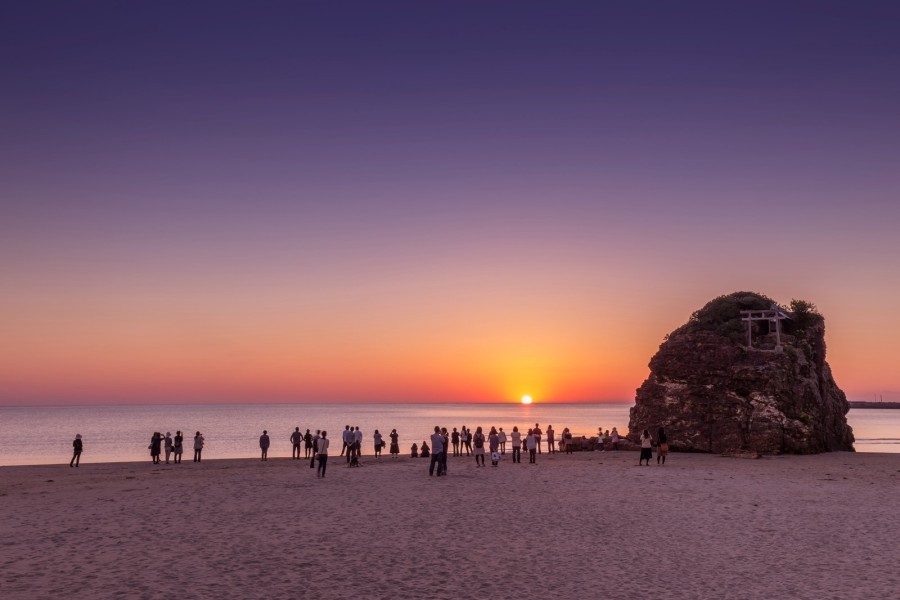Explore Japanese Mythology in Hyogo, Shimane and Miyazaki Prefectures

When people use the term “Japanese mythology,” they are often referring to Shinto — one of Japan’s most widely practiced religions that originated here in the archipelago. Shinto teaches that the world is inhabited by kami (deities), who are venerated at shrines and other sacred sites.
Stories of Japan’s most famous kami are recorded in 8th century texts called the Kojiki and Nihon Shoki (also called the Nihongi). These texts state Japan’s islands were created by kami, and settings of these creation myths are believed to correspond to locations in modern Japan such as Hyogo, Shimane and Miyazaki prefectures.
No matter where you come from, these destinations offer an invaluable insight into Japan’s spirituality. They also offer clues as to how Japanese beliefs about the divine intertwine with history, nature and daily life.
Visit Japan’s first island in Hyogo
Long ago, according to the Kojiki, the god Izanagi and goddess Izanami stirred the ocean with a spear. When they raised the spear’s blade, drips of saltwater hardened and formed Onokoro Island. The deities descended to Onokoro and Izanami gave birth to other islands and deities.
Onokoro Island’s location is unknown, but some possible candidates are found on and around Hyogo Prefecture’s Awaji Island. One of these is Onokorojima Shrine, unmissable
The final local Onokoro Island candidate is Nushima, a sparsely populated island off the southern coast of Awaji. Take the Nushima Kisen ferry from Habu Port and hike around to explore local shrines or viewpoints for Kamitategami Iwa — a pillar-like rock formation in the ocean that features a heart-shaped impression.
The true location of Onokoro Island may remain elusive, but Awaji Island is a worthwhile trip, regardless. The Kojiki names it as the first landmass to be created after Onokoro.
Awaji is accessible via bus from Kobe or ferry from Akashi. Rental cars or bicycles are the most convenient way to traverse the island. Cycling Awaji is especially popular with rental shops providing regular and electrically-assisted bicycles.
Watch a sacred sunset in Shimane
According to the Nihon Shoki, the sun goddess Amaterasu is an ancestor of Japan’s imperial family. Amaterasu’s descendants did not always oversee Japan, however. A god named Okuninushi once managed the earthly realm, but he was persuaded to transfer control to Amaterasu’s bloodline. In exchange, Okuninushi requested a grand palace be built for him.
This palace is believed to be Izumo Taisha Shrine in Shimane Prefecture. Izumo Taisha draws numerous visitors because Okuninushi is the god of en-musubi (fateful chance encounters). Anyone seeking favor from this force can pray at Izumo Taisha by making a monetary offering, bowing twice, clapping four times instead of the usual two, silently praying and then bowing once more.
More information about Izumo Taisha and local history is housed nearby at the Shimane Museum of Ancient Izumo, which combines mythological and historical sources to introduce the story of this region (multilingual information is available).
When the day is done, visit a sunset viewing spot such as Inasanohama Beach or Hinomisaki Shrine. Centuries ago, residents of Japan’s ancient capital Nara believed the sun set in the direction of Shimane. This, among other reasons, makes Shimane’s sunset sacred.
Izumo Taisha and other famous destinations are accessible by bus or train from JR Izumo station or Dentetsu Izumoshi station. Rental cars, local guides or tour companies such as ThoughInaka can also assist with transportation.
See mythical performances in Miyazaki
A famous myth tells that chaotic antics from Amaterasu’s brother, Susano’o, drove the sun goddess to hide in a cave and deprive the world of light. She could only be drawn out after a deity named Ame no Uzume performed a comical dance outside the cave, causing a ruckus that Amaterasu was curious to see.
Amano Iwato Shrine, located in the Takachiho area of Miyazaki Prefecture, is said to be the setting of this myth. Amaterasu’s cave is near the shrine, but entering it is prohibited and it can only be viewed from a distance on a tour with the shrine priest.
Hike a short way from Amano Iwato, however, and you can reach Amano Yasukawara — a sacred site featuring a cave which can be entered. Allegedly, Amano Yasukawara is where the Shinto deities met to plan how to bring Amaterasu out of hiding.
To see this myth and others in action, visit Takachiho Shrine, located near the famous Takachiho Gorge. Kagura — a theatrical dance famous for portraying tales of Shinto deities — is performed at Takachiho Shrine nearly every night and anyone who pays admission is welcome to watch (reservations may be required).
Takachiho is accessible by bus from Miyazaki City, Fukuoka and Kumamoto. Takachiho Shrine is within walking distance of the Takachiho Bus Center while Amano Iwato is accessible via local bus or rental bicycle. E-bikes are available at the tourist information center inside the bus center (same-day rentals and reservations are available except on rainy days).
The adventure continues
Hyogo, Shimane and Miyazaki represent a handful of Japan’s spiritual and mythological hubs. Anyone interested in Amaterasu and Japan’s imperial family should visit Ise Jingu in Mie Prefecture, while fans of yokai (creatures from traditional folklore) shouldn’t miss Mizuki Shigeru Road in Tottori Prefecture. A whole world of Japanese mythology awaits anyone interested in exploring it.
